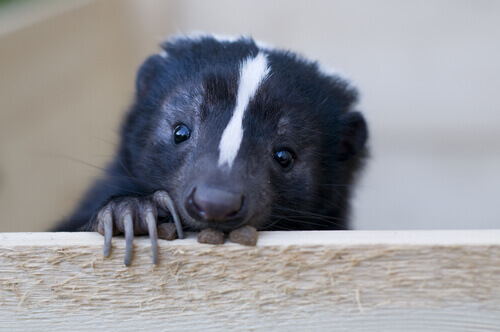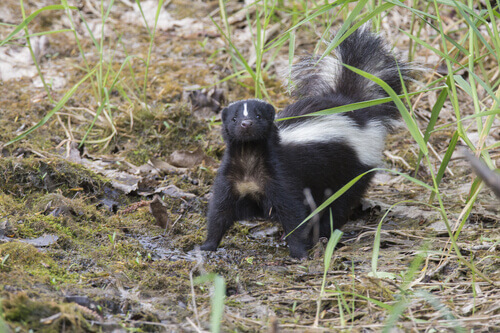The Skunk and its Famous Stink

You might know them from the Looney Tunes animated character Pepe Le Pew, or just simply because they’re famously smelly animals. In this article, we’ll tell you all about the skunk, a very stinky mammal… but at the same time very cute!
Characteristics and habitat of skunks
Skunks are medium-sized mammals whose fur is black with white stripes of various widths. They live in dens that they build themselves, which are up to ten feet deep and which divide into rooms or chambers. They use their clawed front legs as shovels and can also take over burrows or dens abandoned by other species.
There are several species of skunk throughout the Americas. For example, Argentina has brown skunks; Central America, Colombia and Brazil have the spotted skunk, and Central and North America have long-tailed skunks, which have the typical white spot on their backs. There’s also a subspecies in Southeast Asia.
Skunk behavior and feeding
Skunks are omnivorous and feed mainly on insects, fruit, eggs, small mammals, honey, and birds. Males are very solitary and rarely encounter other skunks, as their territory is usually somewhat limited. They only cross the limits of their territories when they’re looking for a female to mate with in late winter or early spring.

As regards their reproduction, the female has a gestation period of 55 days and can give birth to up to 10 cubs, which feed on their mother’s milk for two and a half months.
The life of the mother and her babies is more pleasant than that of the male; she stays in the den with the cubs, although they don’t totally hibernate.
On some occasions, the father may decide to stay too, but the conditions must be perfect, especially in terms of space. And when the winter is very harsh, they can even share the same den with raccoons and foxes without problems.
Skunks and their stink
Undoubtedly, the skunk’s main ‘skill’ is the strong, foul odor it secretes from its anal glands, which it releases when it raises its tail or hind legs after producing a shrill, high-pitched sound. This substance can reach a distance of seven feet and is its main defense mechanism.

In nature, the skunk’s odor can permeate trees, rocks or leaves for several days. And in the event of the animal’s death, the stench will linger for up to a month.
If you’ve been sprayed with this substance, you can try a home remedy that should neutralize it. Mix one liter of 3% hydrogen peroxide, ¼ cup of baking soda and a tablespoon of detergent.
You can apply this on different surfaces but be careful as it can bleach fabrics. You can also use it on a dog or cat’s coat if they have been sprayed by a skunk. Obviously, the best way to avoid the bad smell of this animal is to stay as far away from them as possible, and not to scare them (which can be difficult, as they’ll immediately try to defend themselves).
This text is provided for informational purposes only and does not replace consultation with a professional. If in doubt, consult your specialist.